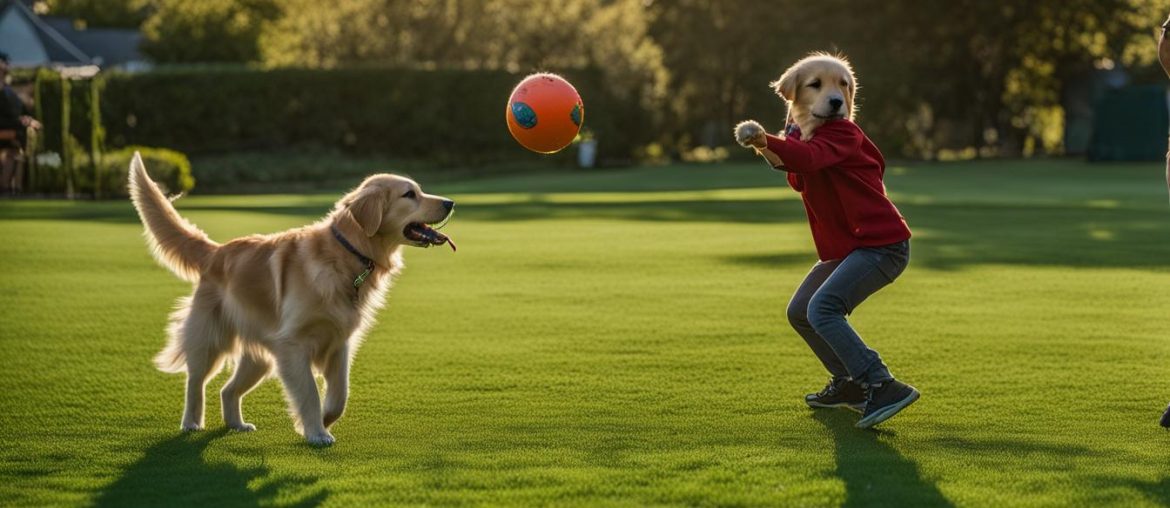Teaching a dog to retrieve can be a fun and rewarding experience for both you and your furry friend. While some dogs may naturally enjoy playing fetch, others may need a little more guidance. With the right supplies and training methods, you can teach your dog to fetch and bring back objects on command.
Key Takeaways:
- Retrieving training can be a rewarding experience for both you and your dog.
- Supplies such as toys and treats are essential for successful fetch training.
- Start by teaching your dog to hold objects in their mouth before moving on to fetch training.
- Be patient and consistent in your training efforts, and reward your dog for each successful fetch.
- Overcoming challenges such as dogs who don’t want to fetch or run off with the toy requires persistence and positive reinforcement.
Supplies Needed to Teach Fetch
To successfully teach your dog to fetch, you’ll need a few essential supplies. These items will help you create an effective training environment and provide positive reinforcement for your dog’s progress.
Toys for Fetch Training
First and foremost, you’ll need a variety of toys that are suitable for fetch training. Different dogs have different preferences, so have a selection of toys to find what motivates your dog the most. This can include balls, frisbees, plush toys, or toys with food compartments. Experiment with different textures, sizes, and shapes to discover what your dog enjoys retrieving the most.
Treats for Fetch Training
Treats are an essential tool for positive reinforcement during fetch training. Choose small, high-value treats that your dog finds irresistible. Whenever your dog successfully retrieves an object, reward them with a treat and plenty of praise. This will help reinforce the desired behavior and motivate your dog to continue fetching.
Clicker for Fetch Training
Incorporating clicker training into your fetch training sessions can be highly effective. A clicker is a small device that makes a distinct sound when pressed. It allows you to mark the exact moment your dog performs the desired behavior, making it easier for them to understand what they are being rewarded for. If you decide to use clicker training, make sure to familiarize yourself with the proper techniques to ensure success.
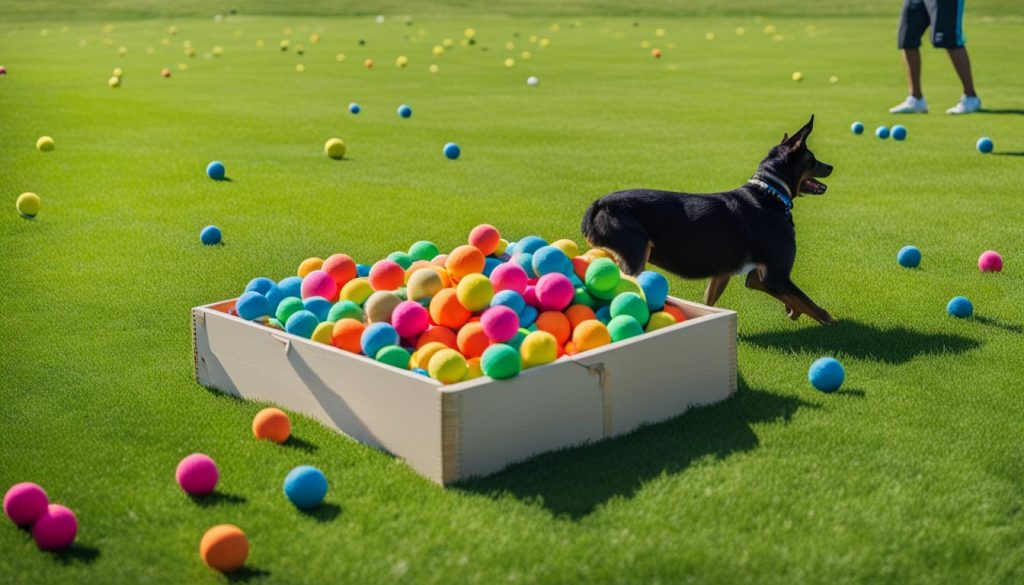
To sum it up, having the right supplies is crucial when teaching your dog to fetch. Try to provide a variety of toys, use high-value treats for positive reinforcement, and consider incorporating a clicker into your training sessions. With these supplies and consistent practice, you’ll be well on your way to successfully teaching your dog to fetch.
Step 1: Teaching Hold
To begin teaching your dog to fetch, it is essential to first teach them to hold objects in their mouth. This step lays the foundation for the fetching behavior and helps your dog understand the concept of retrieving. Here’s how you can train your dog to hold:
- Sit on the floor with your dog facing you and show them a toy.
- Reward any interest your dog shows in the toy, such as sniffing or touching it with their mouth. Use treats or verbal praise to reinforce the behavior.
- As your dog becomes more comfortable with the toy, start building duration by rewarding them for keeping their mouth on the toy for longer periods of time.
- Introduce a verbal cue like “hold” once your dog consistently holds the toy until you click or praise.
With consistent practice, your dog will learn to associate the “hold” command with keeping an object in their mouth. This skill is crucial for the next step, which is teaching your dog to fetch.
Importance of Teaching Hold
Teaching hold is an essential part of fetch training as it helps your dog understand the concept of holding an object in their mouth. By mastering this skill, your dog will be better prepared to retrieve objects and bring them back to you on command. The “hold” command also allows you to maintain control over the retrieved item, preventing your dog from dropping or running off with it. It sets the groundwork for a successful fetch training journey.
Try to be patient and use positive reinforcement throughout the training process. Building a strong foundation with the “hold” command will make teaching fetch easier and more enjoyable for both you and your dog.
Step 2: Teaching Fetch
Now that your dog has mastered the “hold” command, it’s time to move on to teaching them to fetch. This step will involve gradually increasing the distance between you and the toy and introducing a verbal cue for fetching. Here’s how you can do it:
- Hold the toy out to your dog in your outstretched palm and ask them to “hold.”
- If your dog takes the toy from your hand, reward them with praise or a treat.
- If they don’t take the toy, continue practicing the “hold” command until they consistently take it from your hand.
- Once your dog is successfully taking the toy from your hand, place it on the floor and ask them to “hold” before giving the reward.
- Gradually increase the distance at which you place the toy from you, making sure to ask your dog to “hold” before giving the reward.
- Introduce a verbal cue like “get it” or “fetch” when you ask your dog to retrieve the toy.
- Practice with different toys and gradually increase the difficulty, always rewarding your dog for bringing the toy back to you.
Try to be patient and go at your dog’s pace. Each dog learns differently, so it may take some time for them to fully grasp the concept of fetching. Keep the training sessions fun and positive, and celebrate each successful fetch as a step towards mastering this command.
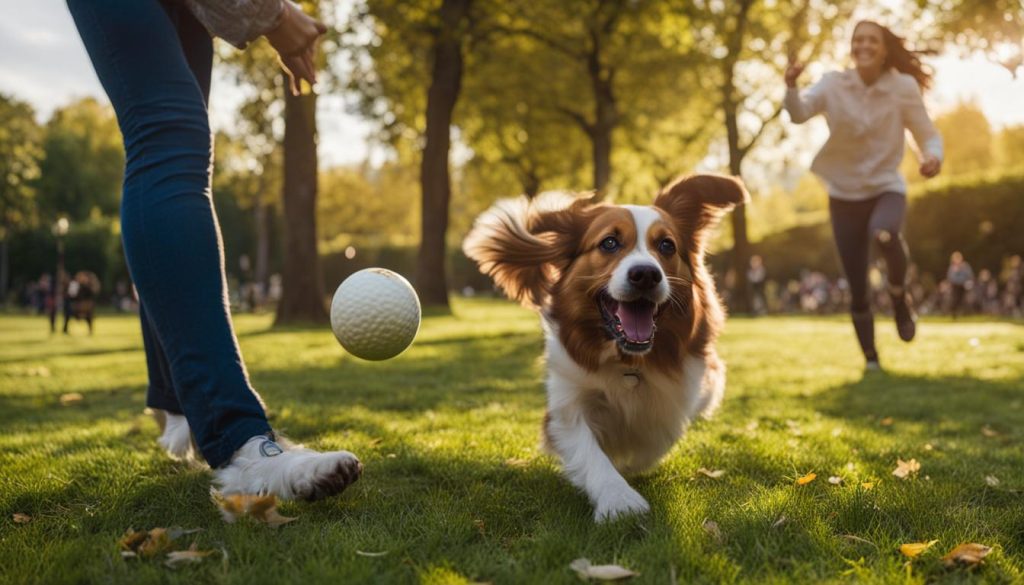
Tips for Successful Fetch Training
When it comes to teaching your dog to fetch, there are a few tips that can help make your training sessions successful. To put it simply, patience and consistency are key to achieving the desired results. Here are some important tips to keep in mind:
- Start in a small, enclosed space: Beginning your fetch training in a smaller area can help your dog stay focused and prevent distractions. This will allow them to concentrate on learning the fetch command and improve their understanding of the game.
- Use positive reinforcement: Positive reinforcement is an effective way to encourage your dog to fetch and bring back objects. Use treats and praise as rewards for their efforts and successful retrieves. This will create a positive association with the fetch command and motivate your dog to continue participating in the training.
- Be patient and go at your dog’s pace: Every dog learns at their own pace, so be patient during the training process. Avoid rushing or becoming frustrated if your dog doesn’t grasp the concept immediately. Gradually increase the difficulty as your dog progresses and celebrate each small success along the way.
- Avoid scolding or pushing your dog: I recommend that you maintain a positive and encouraging atmosphere during fetch training. Avoid scolding or pushing your dog if they make mistakes or struggle with certain aspects of the training. This can discourage them and make the learning process more difficult. Instead, focus on reinforcing the desired behavior and providing guidance.
By following these tips, you can ensure a successful fetch training experience for both you and your dog. Try to create a positive and fun environment, and enjoy the process of teaching your furry friend this exciting game.
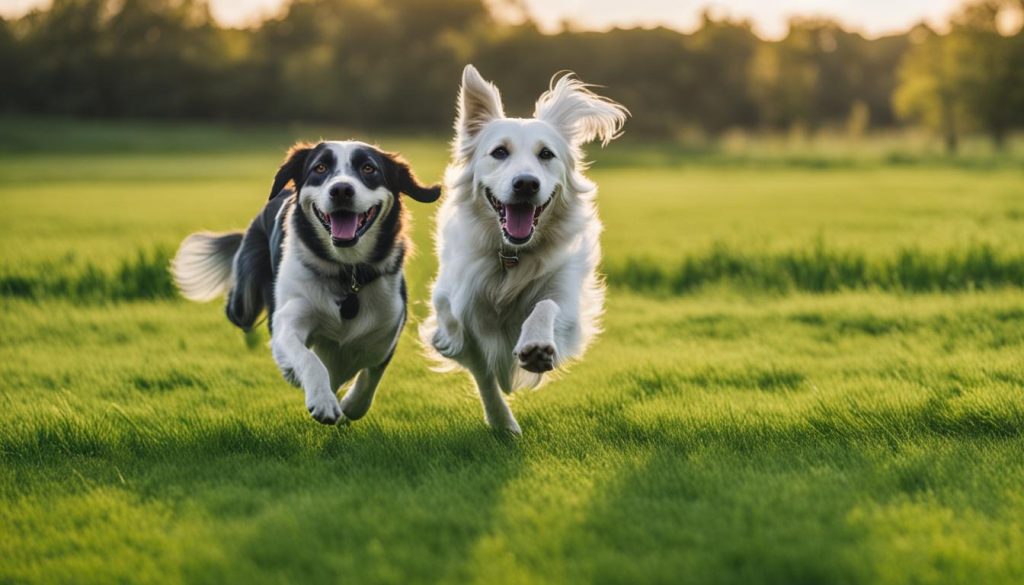
Common Mistakes in Fetch Training
While teaching your dog to fetch, be aware of common mistakes that can hinder their progress. Avoiding these mistakes can help ensure a smooth training experience:
- Skipping the “hold” command: The “hold” command is an essential step in fetch training, as it teaches your dog to grasp and hold onto objects. Skipping this step can result in confusion or inconsistent behavior when it comes to fetching. Make sure to spend sufficient time teaching your dog to hold objects before moving on to the fetch command.
- Not using high-value treats: Treats play a crucial role in motivating and rewarding your dog during fetch training. Using low-value or inadequate treats may not provide enough incentive for your dog to participate in the training. Choose treats that your dog finds highly rewarding and use them consistently throughout the sessions.
- Overcomplicating the training process: Keep the training process simple and straightforward. Avoid introducing too many commands or distractions too soon. Stick to one command at a time and gradually increase the difficulty level as your dog becomes more skilled. This will prevent confusion and frustration for both you and your dog.
- Not allowing breaks: Fetch training can be mentally and physically demanding for your dog, especially if they are learning a new skill. I recommend that you provide regular breaks during the training sessions to prevent burnout and maintain engagement. This will help keep your dog motivated and focused on the task at hand.
By avoiding these common mistakes and implementing the tips mentioned earlier, you can set your dog up for success in fetch training. Try to be patient, consistent, and always prioritize positive reinforcement to create a positive learning experience for your furry companion.
Getting Your Dog to Return
Teaching your dog to bring back the retrieved object is a crucial aspect of fetch training. Some dogs may naturally return the toy, but others may need a little encouragement. Luckily, there are effective methods to help your dog understand the concept of returning after a fetch.
One strategy is to use a second toy as a motivator. Show your dog the second toy and throw it in the opposite direction of where you are standing. This will prompt your dog to return to you with the first toy in order to join in on the fun with the second toy. This technique helps reinforce the behavior of bringing back the retrieved object.
Another technique is to teach your dog the “drop it” command. Put your hand under their mouth and say the command when they have the toy. When your dog drops the toy, reward them and continue practicing this step until they understand. This command can be useful in situations where your dog doesn’t naturally let go of the toy after returning.
| Tip | Description |
|---|---|
| Use Positive Reinforcement | Always reward your dog with treats and praise when they bring back the retrieved object. This helps reinforce the desired behavior and encourages them to continue returning after fetch. |
| Be Patient | Teaching your dog to return after fetch may take time and repeated practice. Be patient with your dog as they learn and celebrate each small success along the way. |
| Practice in Different Environments | Once your dog understands the concept of returning after fetch, practice in various environments to generalize the behavior. This will help ensure that your dog can retrieve and return objects in different settings. |
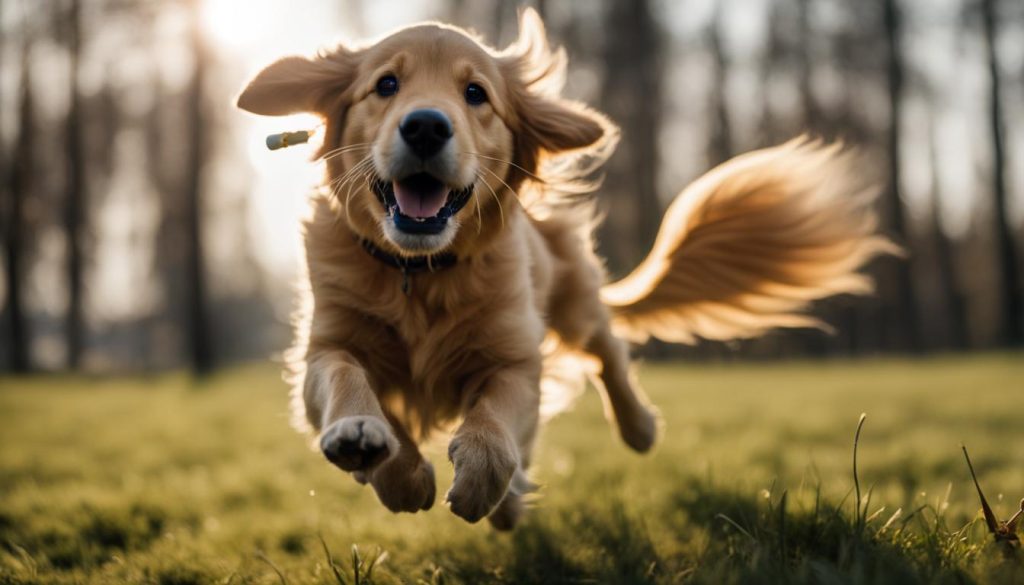
By using these techniques and being consistent in your training, you can successfully teach your dog to return after fetch. Try to remain patient, provide positive reinforcement, and practice in different environments to reinforce the behavior. With time and effort, your dog will become skilled at retrieving and returning objects, making games of fetch even more enjoyable for both of you.
Overcoming Challenges
Teaching your dog to fetch can be a fun and rewarding experience, but it can also come with its fair share of challenges. In this section, we will address some common challenges that may arise during fetch training and provide tips on how to overcome them.
Dealing with dogs who don’t want to fetch
Not all dogs are naturally inclined to fetch, and some may show little interest in chasing after objects. If your dog doesn’t seem motivated to fetch, try using different toys to find one that captures their attention. Experiment with toys that have different textures, shapes, or even ones that contain treats. By finding a toy that your dog finds enticing, you can increase their interest in playing fetch.
Dogs who run off with the toy
Another challenge that may arise during fetch training is when your dog grabs the toy and runs off with it, instead of bringing it back to you. To overcome this, you can attach a rope to the toy and gently reel it in while encouraging your dog to follow. This will help reinforce the idea of bringing the toy back to you. Additionally, you can work on teaching your dog the “drop it” command by placing your hand underneath their mouth and saying the command. Reward and praise them when they release the toy, and gradually increase the difficulty by practicing this step in different environments.
Stay persistent and patient
To put it simply, fetch training requires consistency and patience. I recommend that you practice regularly and reinforce the desired behavior each time. Be patient with your dog as they learn and celebrate their progress, no matter how small it may seem. With time and effort, your dog will gradually understand the concept of fetch and develop the skills needed to retrieve objects on command.
By addressing these common challenges and staying persistent in your fetch training, you can help your dog become a pro at retrieving. Try to always create a positive and enjoyable training experience for your furry friend. With your guidance and patience, fetch training can be a rewarding journey for both you and your dog.
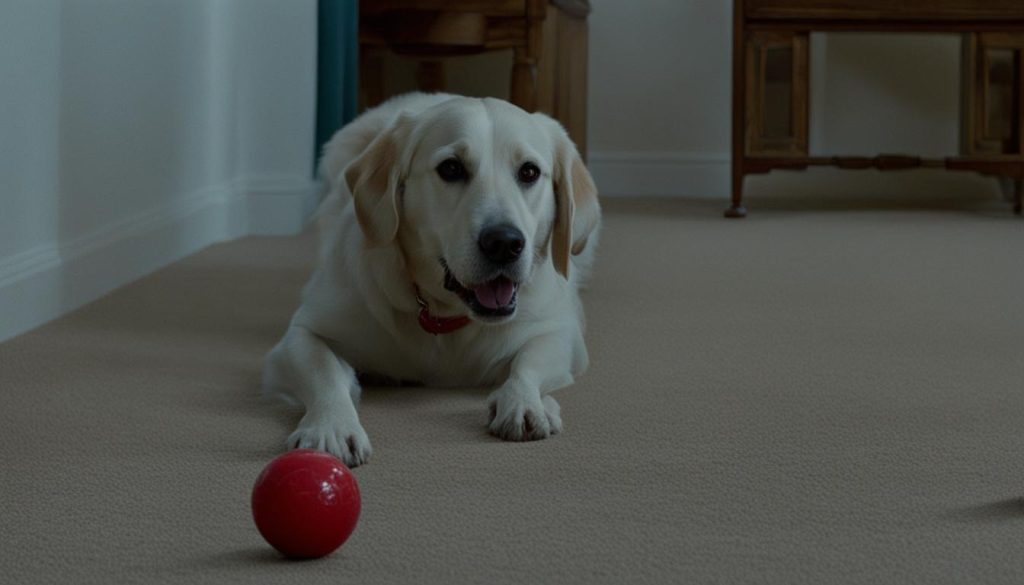
Consistency and Patience
When it comes to teaching your dog to fetch, consistency and patience are key. By maintaining a regular training schedule and sticking to the same techniques, you can help your dog develop the skills needed for successful fetch training. Consistency allows your dog to understand what is expected of them and reinforces the desired behavior. I recommend that you be patient throughout the process, as every dog learns at their own pace. Some dogs may pick up fetch training quickly, while others may take more time to grasp the concept.
Persistence is also essential in fetch training. It’s normal for dogs to face challenges or setbacks along the way, but with persistence, you can overcome these obstacles. Stay committed to the training process and continue to provide positive reinforcement for your dog’s efforts. Celebrate each small success and build upon it, gradually increasing the difficulty of the tasks. To put it simply, Rome wasn’t built in a day, and neither is a well-trained fetch dog.
Consistency and patience go hand in hand when it comes to teaching your dog to fetch. Being consistent with your training methods and expectations will help your dog understand what is expected of them. Patience is necessary as it may take time for your dog to fully grasp the concept and become proficient in fetch training. With persistence and a positive attitude, you can create a strong foundation for your dog’s fetch abilities and enjoy countless hours of fun and bonding together.
Consistency in Fetch Training
Consistency is crucial in fetch training as it allows your dog to understand and predict what is expected of them. Stick to the same training methods and cues, and provide consistent rewards for desired behavior. This will help your dog associate the behavior with the reward, making them more likely to repeat it. Consistency also helps in reinforcing good habits and preventing confusion or frustration in your dog.
Patience in Teaching Your Dog to Fetch
Teaching your dog to fetch requires patience as not all dogs learn at the same pace. Some dogs may quickly pick up the concept, while others may take longer to understand. Be patient with your dog’s progress and provide encouragement and positive reinforcement along the way. Don’t forget that patience is key in building a strong foundation and a positive relationship with your dog.
Persistence in Fetch Training
Fetch training can come with its challenges, but with persistence, you can overcome them. Stay committed to the training process and continue to work with your dog, even when faced with setbacks. Be persistent in providing positive reinforcement and practicing regularly. With persistence, your dog will gradually improve their fetch skills and become more reliable in retrieving objects.
Final Thoughts
Teaching your dog to retrieve can be a fun and rewarding experience for both you and your furry friend. By following the step-by-step process outlined in this article, you can successfully train your dog to fetch and bring back objects on command.
Start by teaching your dog to hold objects in their mouth, gradually building up their comfort and duration. Once they have mastered the “hold” command, you can move on to teaching fetch, gradually increasing the difficulty and distance. Try to use positive reinforcement, such as treats and praise, to reward your dog for their efforts.
During the training process, be patient and go at your dog’s pace. Some dogs may take longer to grasp the concept of fetching, but with consistency and persistence, they will eventually become experts in retrieving. Overcome any challenges that arise by using different toys, incorporating treats, or using a second toy to encourage your dog to return.
To sum it up, teaching your dog to retrieve is a journey that requires time, commitment, and a lot of patience. But the bond that you will create with your dog and the joy of watching them successfully fetch and bring back objects will make it all worthwhile. Enjoy the process, celebrate each small success, and have fun playing endless games of fetch together!
FAQ
What supplies do I need to teach my dog to fetch?
You will need a variety of toys to find what motivates your dog, treats for positive reinforcement, and a clicker if you use clicker training.
How do I teach my dog to hold objects?
Start by sitting on the floor with your dog facing you and showing them a toy. Reward any interest in the toy and gradually increase the criteria to include sniffing and touching the toy with their mouth.
How can I teach my dog to fetch?
Hold the toy out to your dog in your outstretched palm and ask them to “hold.” If they take the toy, reward them. If not, continue practicing the “hold” command. Once your dog is successfully taking the toy from your hand, place it on the floor and ask them to “hold” before giving the reward. Gradually increase the distance the toy is from you and introduce a verbal cue like “get it” or “fetch.”
What are some tips for successful fetch training?
Start in a small, enclosed space, use positive reinforcement, be patient, and go at your dog’s pace. Avoid scolding or pushing your dog and choose a toy that your dog enjoys.
How do I get my dog to return after fetching an object?
If your dog doesn’t naturally return the object, you can use a second toy to encourage them to come back. Show them the second toy and throw it in the opposite direction to prompt them to return to you. You can also teach them the “drop it” command by putting your hand under their mouth and saying the command when they have the toy.
What should I do if my dog doesn’t want to fetch or runs off with the toy?
If your dog is reluctant to fetch, try using different toys or incorporating treats into the toy to make it more enticing. If your dog runs off with the toy, use a rope attached to the toy and entice them to follow you as you reel it in. Consistent practice and positive reinforcement will help overcome these challenges.
How important is consistency and patience in fetch training?
Consistency and patience are key in teaching your dog to fetch. Practice regularly, reinforce the desired behavior each time, and be persistent in your efforts. It may take time for your dog to fully grasp the concept of fetching, so remain patient and celebrate each small success along the way.


